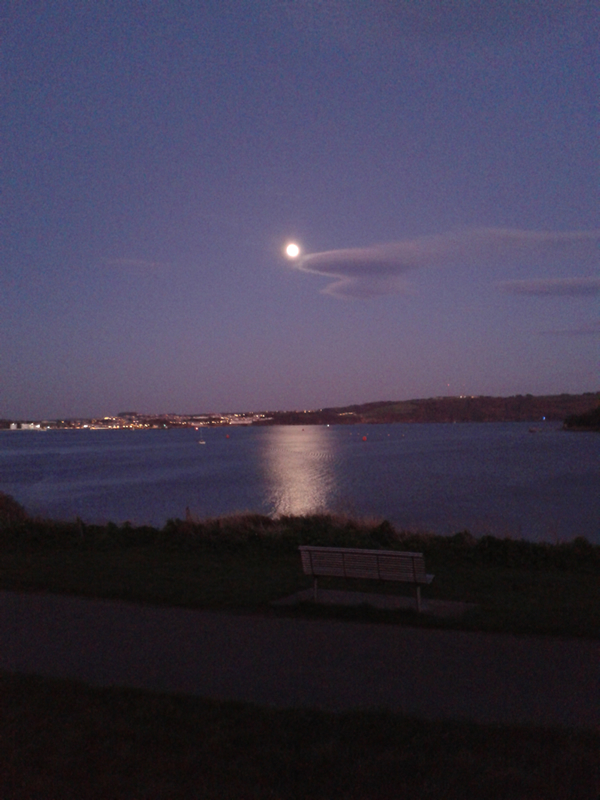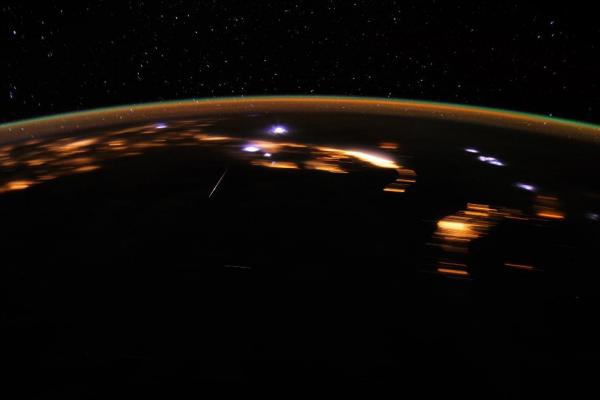Full Moon Over Plymouth Hoe
Here is a photo that I took last March (2014) whilst sitting in my car with my family, eating Fish and Chips, at Devils Point in Plymouth. The photograph is looking back over Plymouth Hoe towards Mount Batten and Jenny Cliff.
I took it on my phone as I hadn’t taken my proper camera as I wasn’t expecting to need it, so I was quite annoyed when this scene unfolded before my eyes. My phone doesn’t produce the best photographs when it is dark, but I though this one came out pretty good!
It was a full Moon at about 17:30 so it wasn’t fully dark, but dark enough so that the light of the very bright Moon glistened off of the sea, directly in front of us. It looked absolutely beautiful, especially when a few clouds started to go across the Moon, which made it look somewhat magical.
It was pure luck that we were there at this time, but we were all glad of it and enjoyed the view until we left (and also the Fish and Chips that were delicious!).
The Fermi Paradox
I came across this article late last year and was totally amazed by it and the ideas that it put forward. If you like astronomy, stars, aliens and anything to do with the Universe, have a read via the link below. It may possibly turn out to be the best blog post you have ever read, it certainly was for me! ENJOY!
http://waitbutwhy.com/2014/05/fermi-paradox.html
Comet Lovejoy
If you are currently lucky with the weather (we are not in Plymouth!), you should be able to see Comet Lovejoy (Comet C/2014 Q2 Lovejoy) in the night sky now. Ideally, it is best to go to a dark area, such as a moor or rural location, as it will be much easier to see it, although you will probably be able to make it out with the naked eye in a more built up area. The very best way to view it would be to go to a really dark place and have a look at it through some binoculars. It will appear like a glowing green blue ball, due to the fact it is made of ice.
The comet was only discovered last year by an Australian astronomer called Terry Lovejoy, but it has been found to have been orbiting the Sun and is about 44 million miles away from the Earth (as of now). So there is no chance that it will hit us! 😉 The last time it came through our part of the Solar System was 11,500 years ago and it won’t be back for another 8,000 years. We will all be travelling around in space by then I think! It appeared closest to Earth on January 7th, but is still going to be a really good view for at least another 10 days, until it will gradually get fainter and fainter as it moves further away from us.
To find Comet Lovejoy in the Sky, you will need to look towards the South of the Constellation Taurus and to the West of the upper half of the Constellation Orion. As the days go on, it will obviously travel onwards and eventually through the edge of Taurus and near to the Pleiades. It should be pretty straight forward to spot if you know your basic Constellations.
This is a great Comet to view and I am crossing my fingers that our skies clear enough for me to have a good look at it! 😉
The Geminids 2014
Over the weekend was the peak of the annual Geminid Meteor Shower. This year, it was actually clear skies over our house meaning the sky was perfectly clear. In fact, it was the best clear sky that we have had for a very long time! There was no moon and the stars and constellations were twinkling beautifully in the night sky. Of course, being this time of year, it meant the clear sky made the temperature absolutely freezing! In fact, it was minus 1.2 by 22:30 so we were quite chilly stood outside!
My wife and I went out to look on two occasions in the evening. The first viewing lasted for about 45 minutes, starting at about 19:45 on Saturday. I was out on my own at first but didn’t see any meteors until my wife made an appearance, which was about 20 minutes in to the viewing. I did have a great time using my camera to try and take photos of the constellation Cassiopeia and the Pleiades but unfortunately my lens wasn’t big enough, so all I took was darkness. It took me a few minutes to get my bearings on where the meteors would originate from, but found that it was directly behind our house. This meant we could stand on the back step and be looking in the correct direction. The only problem with this was that there is a big house directly behind ours, which blocks out the sky. This meant that we had to look directly up, which gave me neck ache the next day!
Anyway, the first viewing picked up and we eventually saw about 8 meteors. Some were very small flashes in the Sky, whilst others zoomed along and left a nice long tail behind. It was great, but we eventually got so cold that we had to go in and have a hot chocolate to drink!
We went back outside at about 10pm for about 30 minutes, by which time the rate of meteors passing by must have picked up as we were treated to some really good ones that shot across the sky and had some amazing tails. The origin of the meteors had passed to the side of the house behind us as well, so we had a clearer view of Gemini by then. I have to say that the constellation Orion looked excellent and very bright as well, which was to the south east of Gemini. At one point we must have seen about 3 big meteors in the space of about 15 seconds, and they were all over the sky. It was great! But, as mentioned above, the temperature had reached sub zero levels by now, and we were just too cold, so we called it a night. In this time we saw about 10 really good meteors, which was very pleasing.
The Geminid Meteor Shower of 2014 was probably the best one that we have seen from our house in Plymouth. The moon was down, the sky was dark and the starts shone so brightly. It was an amazing sight, and to see lots of meteors as well topped it of brilliantly! Here’s hoping for more nights like this when future meteor showers are due! 😉
Lyrids Meteor Shower 2014
For the Lyrids Meteor Shower this year, the Moon is going to keep the sky quite light, which will make it much harder to see them. Saying that, it should still be possible, especially when they are at their peak on the 23rd April. I say this as I happened to be outside this past Tuesday night, watching the ISS fly over Plymouth, and to my surprise, whilst it was moving through Ursa Major (specifically the Plough part of the constellation), there were 5 or 6 tiny little explosions going off in the sky nearby. I couldn’t quite believe it really and it put me off watching the ISS (which I always find fascinating!).
I watched for several more minutes and saw several other meteors in the sky, in the general area of the sky off to the left of Ursa Major. These were not massive meteors as far as I could tell, as you only saw them for a split second, but this was probably due to the almost full moon which was keeping the sky bright and hiding all but the most brightest stars. These weren’t like the tiny explosions I saw during the ISS flyover, but more meteor like. I can only presume these were the Lyrids and the first batch I saw were so small and didn’t ‘shoot across the sky’ but burnt up as soon as they hit the atmosphere of the Earth. The second batch must have been slightly bigger and lasted longer when hitting the atmosphere. Either way, it was great viewing!
The Lyrids Meteors emanate from the constellation Lyra (hence their name) and they are part of the comet Thatcher that takes about 415 years to orbit the Sun. The peak of the shower is usually around the 21st to the 24th of April but they can be seen for several days before and after, depending on how lucky you are! I guess I was very lucky the other night!
Enjoy the Lyrids Meteor Gazing!! 😉

